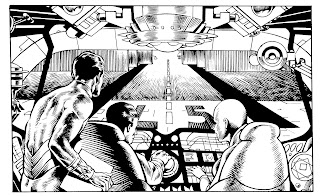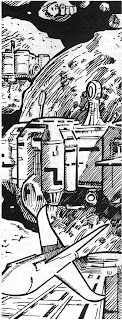November is Buck Rogers Month here at "Julian Perez Conquers the Universe," and in that spirit, here's a look at the recent (2009 to today) Buck Rogers comic from Dynamite Entertainment by Scott Beatty and the incredible Carlos Rafael, an artist with a tremendous amount of talent for a guy with two first names.
A while back I compared Buck Rogers to the Final Fantasy series, in that nearly every version of Buck Rogers in existence are totally different to the point of total unrecognizability, with zero in common except a hero who is a man from modern-day.
This variation is shockingly far beyond even the usual tweaks made with a long-lasting pop culture hero with different media adaptations. James Bond, the Green Hornet and Superman may have crucial differences in every radio, movie and television version, but at least there's something recognizable about say, every Superman take, even wildly divergent ones like Smallville or the 1940s radio show.
(The second greatest science fiction commandment? Thou shalt not have a cute little kid supergenius.)
There are even some references to the version of Buck Rogers I'm most familiar with, the Buck Rogers XXVC roleplaying game, including the presence of monstrous, muscular deformed creatures called "Gennies" including some who actually look like the monster from the cover of a Buck Rogers XXVC adventure ("A Matter of Gravitol," which had a pretty cheesy resolution but was a good adventure overall), and earth is divided into city Orgs, just like with XXVC.
The Han Airlords from the original 1919 "Armageddon 2419 AD" novel are here, though they're not the main bad guys. It is pleasant to discover they still have their Gernsback-esque, spotlight-like Dis Rays. This blew me away because I never, ever thought to see the Han in any Buck Rogers project, although this time they're not Asian anymore…not even the politically correct green-recoloring given to space Asians like Ming the Merciless and Jonny Quest's Dr. Zin so they don't look like super-racist chrome-yellow comic book Fu Manchus.
(Anyone else think of the Shaver Mystery when they hear "Dis Rays?" That's why I always had trouble ever accepting anybody ever thought Shaver was telling the truth: everything about the Shaver Mystery was way too 1940s to be about a real interior civilization.)
One new addition is that of hyper-evolved animals who occasionally hunt humans. This has a lot of great imagery and leads to some fun moments, including a twist reveal that average people will find surprising but people even moderately into science fiction will see coming from a mile away.
By the way, the minute I found out about the animal-people I kept thinking "okay, this is the context the Martian Tigermen will show up" (hopefully this time not as a lame scarred bald guy). I mean that makes sense, right – especially since this comic is full of winking little nods to previous takes on Buck Rogers?
It never fails to amaze me how Buck Rogers creates big science fiction ideas in which new takes on traditional characters would totally make sense, and then fail to use it. For instance, in Buck Rogers XXVC, it's established uploaded minds reside in computers, ghosts in the machine called Digital Personalities, exist. So…wouldn't that be a logical way to throw in Dr. Theopolis from the 1970s show? The idea never really seemed to occur to anybody at TSR.
Unlike the comparatively dated Star Trek, this is definitely what the future will look like…at least from the perspective of right now.
On first reading, I had no idea what the world of Buck Rogers would be like this time (because it's always different) and so the first few issues do a great job of actually being disorienting and creating mystery. Figuring out what things are really like in the 25th Century is the most interesting part of the story.
Like Princess Leia, every time Wilma shoots, she hits something. Not bad for someone with a fat chick name like "Wilma."
 |
| Above: NOT a fat chick. |
By the way, I'm in love with Angelina Jolie as much as every other guy in the whole cosmos, but it was a real mistake to make Ardala and Wilma both blue eyed, black haired thick lipped women, because in panels where they're together it really gets confusing.
Also, with the addition of a black-haired Wilma, Colonel Deer has officially had every single color hair in the entire spectrum!
The comic's Dr. Huer was an incredibly likable, classy, scatterbrained old chap who stays pleasant even when threatened with danger, and the comic has some powerful moments about a time-lost Buck Rogers who lost everything that ever mattered to him. These moments get all the more poignant because they don't overdo them.
Apparently, this series works under the logic moustache = criminal type, so Black Barney's got a killer 'tashe too. In the comic he was yet another stock character dashing rogue who is theoretically supposed to be scene-stealing.
My all-time favorite version of Black Barney is the Buck Rogers XXVC version, but that isn't too hard, though: Black Barney in the 1970s show looked and acted like homosexual community theater version of Sinbad the Sailor hamming it up.
In the 1991 RPG, Black Barney was a combination of the Captain America villain Crossbones with Ice-T, Gully Foyle, and a heaping extra layer of pus, trash and grime, a cynical, black humored, intimidating crook, not too intelligent, not too talkative, but with a totally ruthless cunning like a predatory animal, with absolutely frightening strength and agility, an inhumanly deep and menacing voice, a killer instinct, and zero hesitation to fight dirty. He doesn't smile, laugh or joke around. In the game Barney was a terrifying fighting machine, a scarred, ugly thug who did time, which I always thought was more interesting and truly intimidating than this tendency to make him either a dashing rogue like Han Solo or a sanitized, family friendly Ben Grimm-type tough guy that's really a softie deep down.
Black Barney in the TSR game became a good guy only because he respects power, and therefore respects anybody that can beat him, which Buck Rogers did - that, and curiosity too. After all, Barney was surprised after his failure he wasn't immediately killed. Black Barney gave the setting a badly needed Boba Fett type antihero compared to the squeaky clean and optimistic Buck Rogers.
The Dynamite Buck Rogers comic got that tone and spirit right and does have a few original ideas, but despite all that, it occasionally has the feel of "been-there, done-that." The new Buck Rogers reminds me of a meal with leftovers you have at the end of a week with your family, where it can be a game to spot what dish there came from what meal. The liberal borrowing becomes so obvious at times the pop culture savvy Buck Rogers, even in the comic itself, points it out.
For instance:
- The idea of animals evolved to superintelligence comes from David Brin's "Uplift" novels and the idea said hyperintelligent animals would return after a long time from deep space to menace the human race comes from Leonard Nimoy's "Primortals;"
- The main villain having a wolf tracker henchman comes straight from Maugrim from the Chronicles of Narnia (the guy in this comic was killed off way too fast, by the way – he could have been a recurring baddie);
- The Han Airlords ditched their Zeppelins and have a flying city that looks just like the Hawkmen's from Flash Gordon (seriously, LOOK at it!);
- Ardala and Killer Kane started off as traitors to earth who after being rescued by other humans spend the majority of their existence disguising their guilt and treachery, just like Baltar in the recent Battlestar Galactica reboot;
- Buck and Dr. Huer encounter a race of albinos who live under caves in a hidden vault after a cold war-flavored atomic exchange they believe destroyed the surface, an idea that is the premise of the Fallout games…and they worship unexploded atomic bombs. Even Buck can't resist a wisecrack at this similarity. They're even undone by bright lights, just like "The Mole Men."
All in all, the comic is above average at its best points, and is worth reading if for no other reason than Carlos Rafael's astounding pencils. There are even some bits that are actually funny, like how a plot point revolves around how nobody in the future can read cursive writing. Looking at Carlos Rafael's art I find myself saying...why have I never heard of this guy before?
Also - keep your eyes peeled for the bit where Buck and Wilma put on their 1930s comic-strip inspired suits!











































